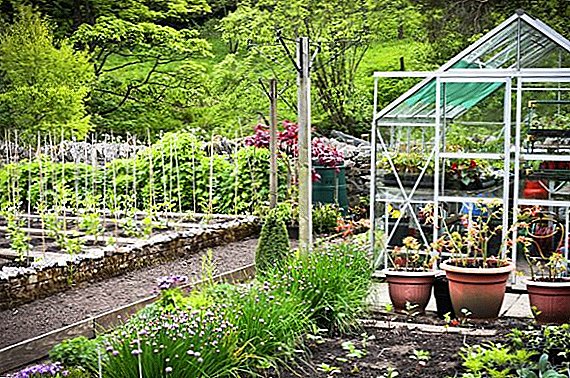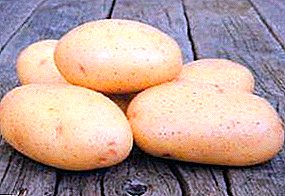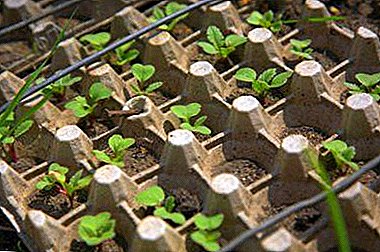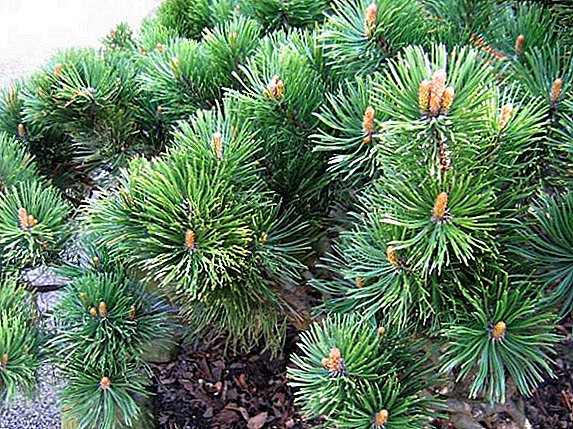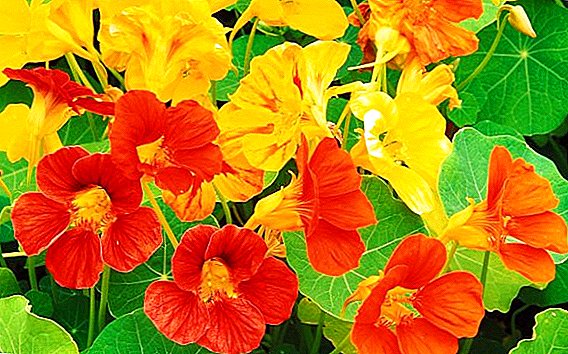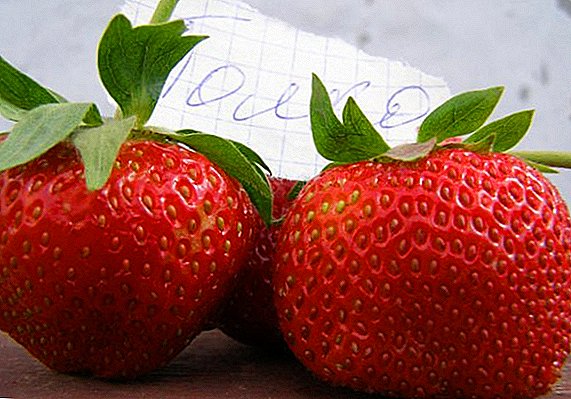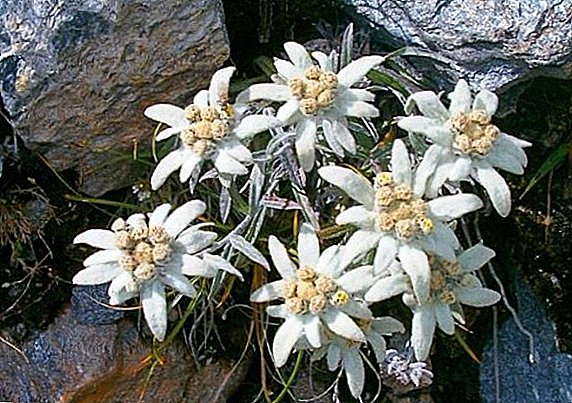 The mountain flower edelweiss is considered to be one of the most mysterious and rare flowers of the Asteraceae family. In the wild, edelweiss grows at an altitude of about 2000 meters above sea level. He likes secluded and difficult terrain.
The mountain flower edelweiss is considered to be one of the most mysterious and rare flowers of the Asteraceae family. In the wild, edelweiss grows at an altitude of about 2000 meters above sea level. He likes secluded and difficult terrain.
Did you know? Edelweiss is depicted on the coat of arms of Switzerland.
Edelweiss grows up to 15 cm, but consists of many stalks. From one edelweiss root can grow up to 20 shoots with small basket inflorescences that resemble stars. The stems and flowers of the edelweiss are similar to a felt product: fluffy and soft and delicate in appearance.
 Edelweiss is protected from cold and fog by a nap, so it seems to be covered with silvery down. In natural growing conditions, edelweiss flowers are very unpretentious, and at the same time they are quite difficult to grow in the garden. But for those who are a romantic, a dreamer and just an esthete, it will not be a problem to grow this beautiful flower.
Edelweiss is protected from cold and fog by a nap, so it seems to be covered with silvery down. In natural growing conditions, edelweiss flowers are very unpretentious, and at the same time they are quite difficult to grow in the garden. But for those who are a romantic, a dreamer and just an esthete, it will not be a problem to grow this beautiful flower.
What conditions do edelweiss need for successful growth?
For successful growth of edelweiss it is necessary to comply with certain conditions. All these factors, of course, depend on the climatic zone in which it will be grown.
Interesting fact! Edelweiss - the flower of love. Giving his beloved, the young man confessed to eternal love for the girl.
Does the edelweiss need the sun, how to choose lighting for the flower
 For the successful growth of edelweiss you need to find a well-lit place. Recommended sites on which there is no stagnation of water on a hill. But at the same time, edelweiss can easily grow in partial shade. It would be good to pick up a territory for him in which the sun will light up the plant before dinner, and in the afternoon will make light penumbra.
For the successful growth of edelweiss you need to find a well-lit place. Recommended sites on which there is no stagnation of water on a hill. But at the same time, edelweiss can easily grow in partial shade. It would be good to pick up a territory for him in which the sun will light up the plant before dinner, and in the afternoon will make light penumbra.
What should be the ground for edelweiss
For planting edelweiss suitable light, loose sandy soil, which easily passes water. The soil should be well dried, with admixture of gravel or coarse sand. Also, be sure to add lime to the ground.
Important! Do not mix soil for planting edelweiss with manure.
Features flower care
Edelweiss - a rather whimsical plant, planting and caring for it requires a lot of effort, but with all the standards of maintenance, you can achieve good results.
What humidity does edelweiss like, how often to water a plant
Edelweiss does not like high humidity. It will suit moderate watering, and only in the dry months.
 The plant does not tolerate stagnant water, so you need to plant it on a hill and try to control the amount of liquid that goes to the edelweiss. After the rain, the plant can not be watered for a month.
The plant does not tolerate stagnant water, so you need to plant it on a hill and try to control the amount of liquid that goes to the edelweiss. After the rain, the plant can not be watered for a month.
Important! From excess moisture, edelweiss can die.
A little about feeding edelweiss
It is highly undesirable to feed edelweiss. He does not tolerate any kind of dressing: both organic and chemical. Especially afraid of fertilizing with humus.
A plant can be fed only if it is frozen, and then only to restore it. Once the plant has come to life, you can not use fertilizers.
Soil care

Edelweiss, in addition to the soil fertilized with limestone, loves to sprout in the snow. Therefore, in the spring, before warming, throw a pile of snow on the old branches of the plant. But if you live in a region where there is no snow, then in the winter you need to mulch the soil. Thus, an imitation of snow cover for the plant will be created. Mulching will need to be removed before spring.
All about flower transplant
Edelweiss has unusually long roots. To transplant it, you need to dig deep holes. When replanting, flatten the roots of the plant, gently dip it in the hole and sprinkle it with dry soil. After transplanting the plant must be watered with a small amount of water.
If the plant has stuck, then side shoots will appear on the main stem. You can call a successful transplant when you see that the plant has started to bush actively and the following year will delight you with its flowering.
Edelweiss Reproduction
Edelweiss can be propagated by seed and vegetative way.
Seed propagation
 It is rather difficult to grow a plant from seeds, but with proper care it is possible. As soon as the snow began to fall, you can start planting edelweiss, just remember that you need to plant with seeds that have been processed. The seeds are very small, difficult to spot and distribute. For their planting, you will need a container with moist non-acidic soil and transparent cans, which then will need to cover the planting.
It is rather difficult to grow a plant from seeds, but with proper care it is possible. As soon as the snow began to fall, you can start planting edelweiss, just remember that you need to plant with seeds that have been processed. The seeds are very small, difficult to spot and distribute. For their planting, you will need a container with moist non-acidic soil and transparent cans, which then will need to cover the planting.
Did you know? The most popular species is the Alpine edelweiss, which, even when grown from seeds, most effectively preserves its specific features.
Mix the edelweiss seeds with sand and gently land in the soil, cover the top with prepared jars. After 10-14 days, the first shoots will appear. Sprouts are so small that even pouring from the pipette you can wash their roots from the soil. Therefore, for watering sprouts edelweiss you need a small atomizer. From a distance of about 20 cm spray the air near the plants, and drops of water fall on them and into the soil. Seedlings are watered on dry soil.
Planted young plants in open ground need in early June. Pick a sunny place for them by preparing the necessary soil composition before planting. When you propagate a plant with seeds, the edelweiss will bloom in the second or third year.
Important! Tubs with planted seeds must be maintained at a temperature not exceeding 15 degrees.
Vegetative reproduction
By propagating the plant in this way, you retain all its inherent characteristics. When reproduction of edelweiss by seeds, it is not always possible to preserve its species characteristics.
If you have an edelweiss growing in your garden, then it is best to carry out vegetative reproduction by dividing the bush. The plant has a very strong root system, which can easily adapt to environmental conditions. They recommend dividing the edelweiss bush in the middle of spring or in early autumn. The plants propagated in this way bloom the following year.

Did you know? Edelweiss looks spectacular at night: under the light of the moon it begins to flicker with a marvelous silver light.
It is also effective to conduct cutting edelweiss. This procedure is done in June. Cut off the tops of last year's shoots and planted in a pre-prepared soil. For it you will need sand, leafy ground and a little lime. In wet soil, at a distance of 10-15 cm from each other, land the tops of the edelweiss and water them on dry soil. The plants will bloom next year.
Edelweiss will look great on alpine hills and rocky gardens. You can combine his planting with flowers that bloom blue, blue and pink, but it is unlikely that you will be able to grow an edelweiss with peony or chrysanthemum, in such a garden it will simply be lost. Edelweiss can be planted near coniferous trees and bushes.


